
Original Link: https://www.anandtech.com/show/3695/the-clarkdale-experiment-mea-culpa
The Clarkdale Experiment: Mea Culpa
by Loyd Case on May 4, 2010 1:57 PM ESTSeveral months ago, I wrote about my little experiment with Clarkdale, where I built a small form factor system, based around a Core i5 661 CPU, an Asus H55 motherboard and a Radeon HD 5850 graphics card. That system also used a pricey, 250GB SSD, which was a little over the top for an otherwise modest system, but the idea was to make it small, quiet and low power.
Quite a few people critiqued the article, and most of the critiques revolved around the lack of performance data. After all, the general feeling went, how do we know this is really a good system? It’s pricey, to be sure, but we also have no way of judging performance.
As it happens, I have another small form factor system in the basement lab, which happens to be running a Core i5 750. Ignoring hard drive performance for the moment, all I really needed to do was swap out the graphics card, since the Lynnfield system was running an older Radon HD 4870. So I dropped in a Radeon HD 5850 and took both systems for a spin.
Price versus Performance
There’s a time and place for integrated graphics – but not for PC gaming. Dropping in a Radeon HD 5850 likely means the system will be used for PC gaming – which was my intent all along. The Core i5 661 is priced nearly identically with the Core i5 750. Beyond price, the differences are pretty substantial:
· Clock speed: 3.33GHz (Clarkdale) versus 2.66GHz (Lynnfield)
· Maximum Turbo Frequency: 3.6GHz (Clarkdale) versus 3.2GHz (Lynnfield)
· Dual core with hyper-threading (Clarkdale) versus quad core without hyper-threading (Lynnfield)
· 4MB shared L3 cache (Clarkdale) versus 8MB shared L3 cache (Lynnfield)
· TDP: 87W versus 95W (Lynnfield)
So Clarkdale has a 25% raw clock speed advantage and a 12.5% maximum turbo boost performance. Lynnfield has the edge in cache – while both have a shared L3 cache, the sheer cache size gives Lynnfield an edge over Clarkdale in cache sensitive apps. Lynnfield also has four actual, physical cores, rather than two physical plus two SMT (virtual) cores. Interestingly, Clardale only has a modest TDP advantage over Lynnfield.
With these thoughts in mind, I ran a number of game benchmarks, plus a few other performance tests. Given the clock speed disparity versus cache size and number of cores, I didn’t expect big performance disparities. As it turns out, I was in for a few surprises.
System Configuration
These systems weren’t identically configured, but were similar.
|
Component |
Clarkdale System |
Lynnfield System |
|
CPU |
Core i5 661 @ 3.33GHZ base |
Core i7 750 @ 2.67GHz base |
|
Motherboard |
Asus P7H55-M EVO |
Gigabyte GA-P55M-UD4 |
|
Memory |
2 x 2GB OCZ DDR3-1600 @ 1333 |
2 x 2GB OCZ DDR3-1600 @ 1333 |
|
GPU |
XFX Radeon HD 5850 |
XFX Radeon HD 5850 |
|
Hard Drive |
OCZ 250GB SSD |
WD Caviar Blue 640GB |
|
Optical Drive |
Asus BD-ROM / DVD+/-RW |
Lite-On DVD+/-RW |
|
PSU |
Cooler Master 500W |
Cooler Master 500W |
The key differences in components were motherboards (Asus H55 versus Gigabyte P55) and hard drive (an SSD versus a standard rotating media drive.) None of the tests I ran were particularly storage intensive, and any power advantage due to drive differences were pretty minimal.
Non-Game Performance
Ignoring generic performance benchmarks like Sysmark, I ran a couple of media encoding tests, POV-RAY 2.70 (beta 35a) and Cinebench 10. The idea wasn’t to make any definitive judgment about performance, but just get a feel for how the two CPUs might perform in memory intensive tests.

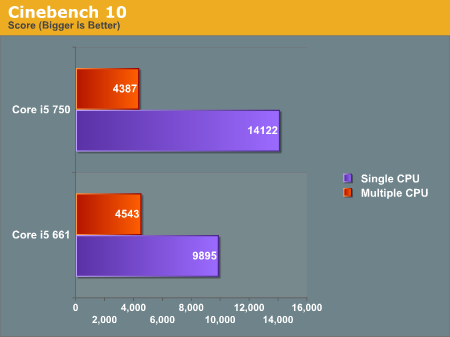
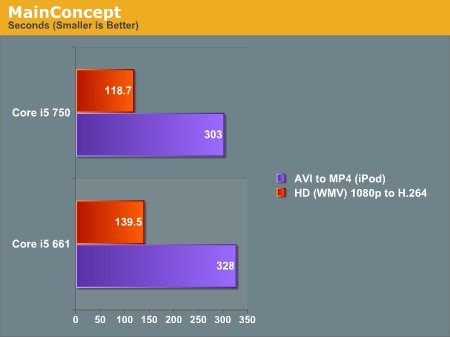
It’s no big surprise that the Core i5 750 outperforms Clarkdale; these apps are multithreaded, and physical cores will trump virtual cores in this class of application. As you can see, in both POV-RAY and Cinebench, Clarkdale’s single core performance is a little higher than Lynnfield – but the differences are much smaller than the even the 12.5% disparity in Turbo Boost peak clock speeds. It’s possible that the L3 cache size disparities have an impact.
But these systems are gaming systems, so let’s take a look at how they perform with games.
The Game is Afoot
I ran a number of games, plus one synthetic benchmark. All tests were run at two different resolutions and detail settings: 1440x900, low graphics settings, and 1920x1080 at fairly high settings. The first, low resolution set of tests represent performance weighted towards the CPU, and are not graphics bound. The second set of tests represent playable resolutions and detail settings, and can be graphics bound in some cases.
· Unigine Heaven (synthetic). The 1440x900 benchmark was run in DX10 mode, the 1920x1080 benchmark run in DX11 mode, with hardware tessellation enabled.
· S.T.A.L.K.E.R.: Call of Pripyat. The lower resolution test was run with the low detail, dynamic presets. The 1080p benchmark was run in DX11 mode, high preset, with hardware tessellation enabled.
· Far Cry 2: Action benchmark. This is one of the included scenarios with the Far Cry 2 benchmark tool, and is pretty CPU intensive – but also represents the game’s more combat-intensive scenes. The low preset was used for the 1440x900 test, the high preset (DX10 enabled) with the higher resolution test.
· Battle Forge. This RTS is CPU intensive, but also implements DX11 graphics in the highest detail modes.
· Tom Clancy’s H.A.W.X. This title is an arcade styleflight sim, with lots of DX10 eye candy.
· DiRT2 (Demo): This rally racing title supports DX11 and DX9, but not DX10.
Let’s take a look at the results.
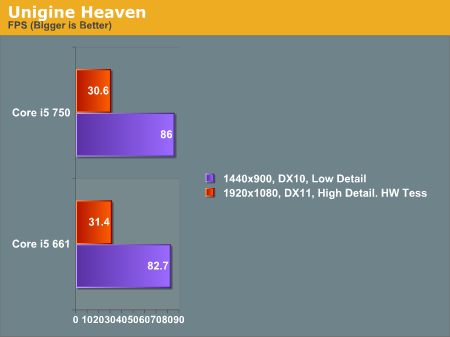
When we keep the resolution and detil levels low (tessellation is off in the low resolution test), the CPU differences are noticeable. Once we dial up the graphics pain, though, the difference is negligible.
Heaven is a synthetic test that pushes certain DX11 features. Let’s see how real games fare.
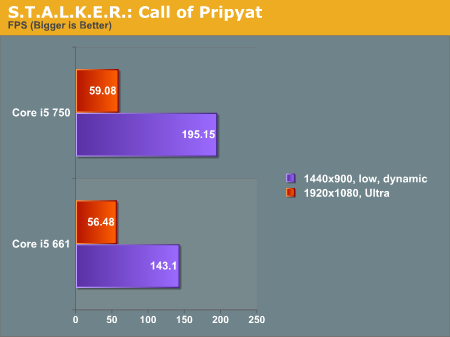
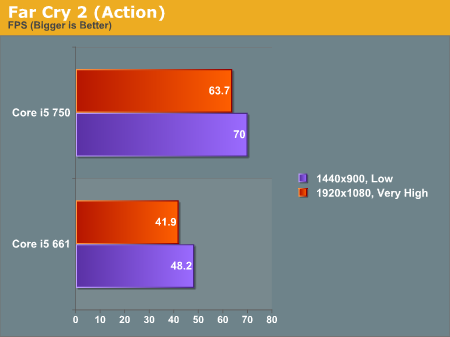

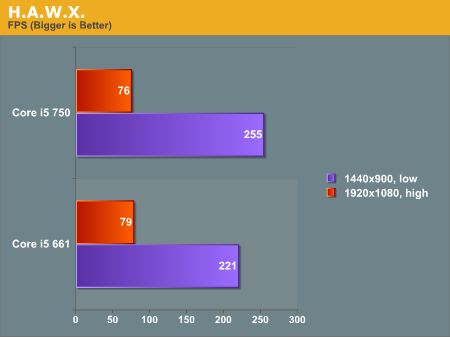
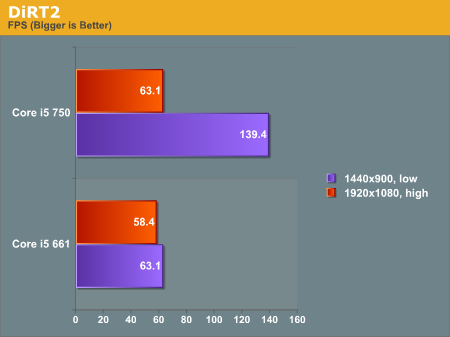
There are some intriguing tidbits in the data. Some of them are a little head-scratching.
Remember, if we run a game at low resolution, with detail levels dialed down, then the game is more likely to be CPU bound than graphics bound. In other words, the CPU impact is exaggerated. If we just look at the low detail results, we see clear wins across the board for Lynnfield. Clearly, if we only ever play games on small displays with crappy visuals, Lynnfield wins out.
The head-scratching part comes in when we dial up the graphics pain. In theory, as you dial up resolution and detail levels, the graphics hardware plays a bigger role, and differences in CPU performance become less noticeable. That’s not true with radical differences in CPU – a slow Celeron compared to a fast Core i7 would run games much more slowly, no matter what GPU is installed. Still, with somewhat similar classes of processors, you’d expect minimal differences.
What we see here, though is a mixed bag. The Far Cry 2 Action scene, for example, still demonstrates a noticeable performance edge for Lynnfield, while we see small, but not insignificant, differences in favor of Clarkdale on Battle Forge and HAWX. Still, the overall edge lies in favor of Lynnfield, with the slower clocked quad core CPU winning in Far Cry 2, DiRT2 and STALKER. These results are pretty much repeatable with multiple runs, too. The numbers vary slightly, but the pattern doesn’t change.
What About Power?
One of the main points of building a Clarkdale system was power usage. Let’s take a look at power usage differences, first at idle, then full throttle.
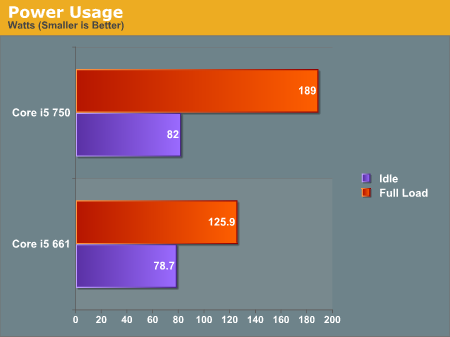
Okay, here’s where Clarkdale shines, especially when you dial up the clock speed. At full throttle, the Lynnfield / P55 combination consumes 189W versus 126 for the Clarkdale system. This translates into heat generated as well.
On the other hand, the goal for this system was to build a compact gaming system. Low power usage would have been ideal for, say, a home theater PC with a lower cost graphics card. If this is really a LAN party gaming rig, the added power draw isn’t as big a deal.
If we postulate playing games four hours a day, five days a week, all year round, the difference in power draw translates to 65KWh over an entire year – and that’s a lot of gaming. That translates to $20 or so spread out over the entire year at $0.30 per KWh. In reality, few people run their gaming rigs full throttle four hours a day – even if they’re playing four hours a day.
Anand was Right
The higher cost SKUs of Clarkdale seem overpriced for the performance you get. Given that the true quad core Core i5 750 and the dual core Core i5 661 are roughly priced at parity, Lynnfield is a better deal. Bear in mind that we’ve been running Lynnfield at its default 2.67GHz clock, too. If you overclock, the story just gets better.
Even power usage doesn’t translate to huge savings in our particular usage model. If I were gulding an HTPC, I’d drop down to a lower priced CPU, and a graphics card with less power draw (and costing less.) For a gaming system, though, Lynnfield looks like a much better solution.
Mea Culpa. Mea Maxima Culpa.







